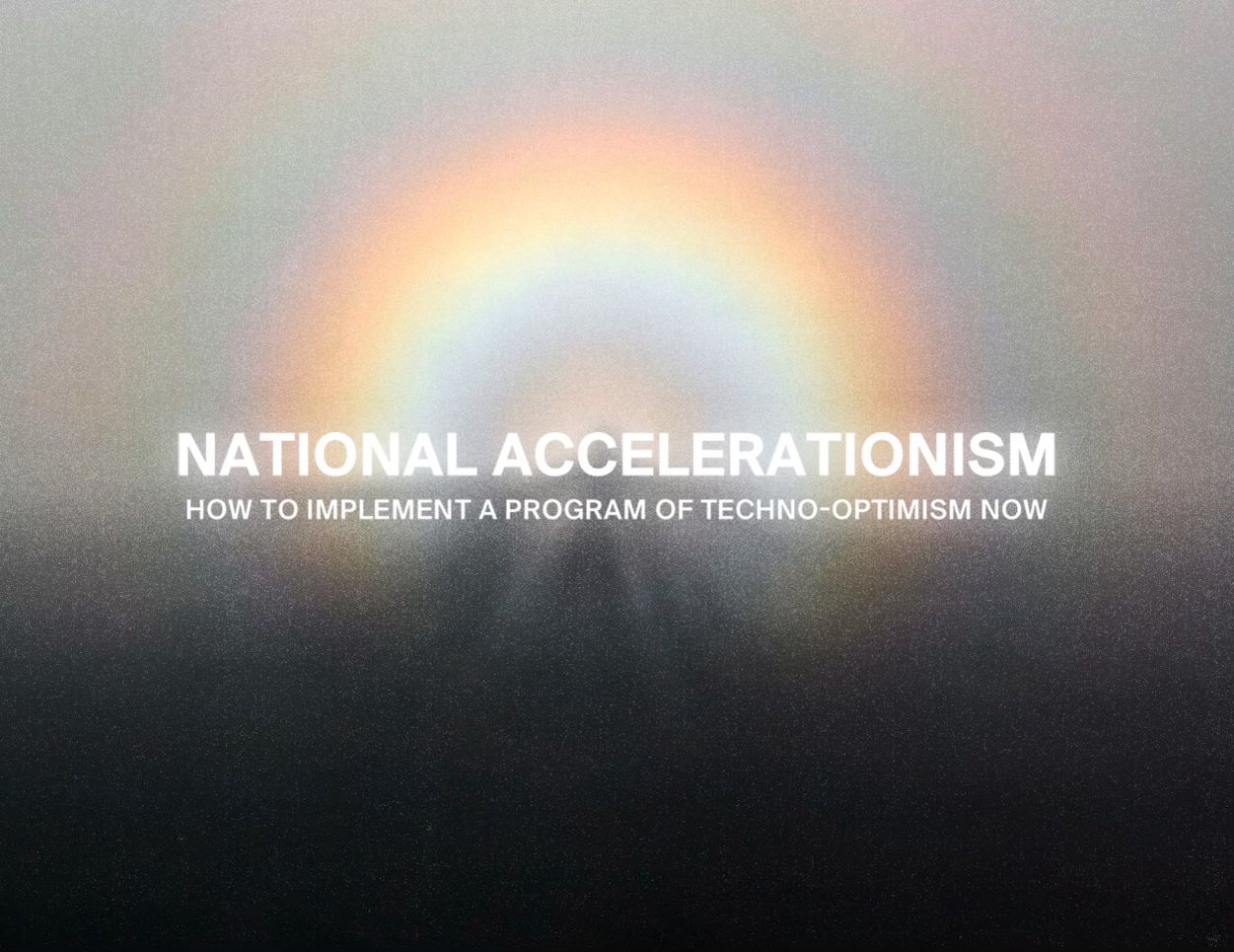

INTRODUCTION.
I want a radically better future. I believe that technology, in coordination with institutions, can deliver it. Beyond philosophy, what follows is a plan that we can begin executing immediately.
Technology.
Technology is the set of tools we use to do new things, and old things better. Technology is how we shape our world and build the future. The moral compass metaphor is instructive: technology is the ship, we're the crew; you still need a compass to get where you're going. And, for that matter, you need to know where you're going. Our values imply our vision for the future. Values tell us what technology to strive for, and how to use it. Technology is a scalar, and values make it a vector. Technology is inextricably linked to our values.
The Exponential.
Technological progress is accelerating. “Compare how the world looked 15 years ago (no smartphones, really), 150 years ago (no combustion engine, no home electricity), 1,500 years ago (no industrial machines), 15,000 years ago (no agriculture),” writes OpenAI CEO Sam Altman. “The technological progress we make in the next 100 years will be far larger than all we’ve made since we first controlled fire and invented the wheel.” Humanity is propelled by technological progress; on a long enough time scale, the exponential appears to be inevitable. Leaps are made by individuals, but humanity always finds a way.
Today, we see inflection points in artificial intelligence, energy, and biotech.
AI is working – products like ChatGPT and Midjourney create labor efficiency by helping us do tasks faster, and gesture at a structural cost reduction in knowledge work. The ultimate promise of artificial intelligence is limitless knowledge, and its application.
In energy, nuclear fusion – which offers virtually limitless, clean energy – is beginning to work in the lab. Private companies are commercializing early, signing contracts with future customers e.g. Microsoft. The consequences of fusion are profound: material cost reduction in the operation of data centers (compute / AI), manufacturing, transportation, and much else; energy is 13% of global GDP. Unlimited energy, in combination with the secrets of the universe learned from superintelligence, unlock an infinite frontier.
Biotech is having a moment as well. Brain-computer interfaces are beginning human clinical trials, and perhaps LLMs or DeepMind's AlphaFold will become a lever in drug discovery and personalized medicine. Healthcare is ~18% of US GDP; further, it is a low-productivity-growth sector, so the 18% is closer to a cost than an investment. The promise of biotech is BCI fusion with superintelligence, and the holy grail: eternal life.
These technologies are interrelated. AI is extremely energy-intensive (e.g. a query on ChatGPT uses about 10x the compute as the same search on Google). Energy is the core input to AI; biotech is a core output.
If exponential technological progress continues, we have an opportunity to live through the most exciting time in human history. We can choose to enter an age of exploration and enlightenment. We can travel to the far reaches of the universe, learn the secrets of reality, and live forever. The exponential unlocks this possibility, and more than we can possibly imagine. But to realize a possible future, we must choose it.
Institutions.
Ideas about how we should live take the form of religions, philosophies, and ideologies; they are spread by the memes we call culture; these memes compel a suprapersonal commitment to a cultural form; and this cultural form, projected through time, is our vision for the future. Institutions are sets of norms and rules that we use to coordinate disparate humans. They guide us towards our vision for the future codified in our values. The Catholic Church, the law, marriage, the SEC, Harvard, and the New York Times are all institutions. Institutions have a duty to protect the spiritual core of society.
The most powerful and important institution in our society is Government. Governments serve as a final backstop, enforcing adherence to the most fundamental rules and norms. Humans are social and need institutions to coordinate; their persistence is inevitable.
Sovereign Alignment.
There is a natural antagonism between technology and institutions. Institutions provide stability. Technology causes change.
Governments view technology skeptically, and technology views governments skeptically. As the custodians of our values and way of life, governments reasonably seek to ensure that tech-driven change furthers a vision for the future that is consistent with their values. Technologists give us the ability to improve our lives, and reasonably seek to avoid governments preventing progress. Governments view economic volatility (especially job automation) as dangerous; technology views economic stagnation as dangerous.
Exponential technological progress will worsen the tension between technology and government. The world will change faster. This will be startling to staid institutions. Threats to our way of life posed by the aimless or destructive application of technology will be met by draconian regulation, which will startle even the most DC-active technologists. The US is already doing this in crypto; nuclear and biotech regulations are onerous as well. The EU regulates benign software.
Regulation can slow technological progress locally, but not globally. Governments can use the lever of the law within their jurisdiction, and effectively in other jurisdictions where they have material influence. Fear of technology is ancient. Plato criticized the invention of writing. While concerns are not always unfounded, technology has always prevailed. Competitive dynamics create an opportunity for adversaries to speed up when you slow down. The costs of going slow include:
- Loss of talent: Talented people will move to places with greater economic opportunity driven by technology. As we’ve seen over the last century, brains drain to technologically progressive societies. This trend will accelerate.
- Loss of capital: If the talent moves, so does the money.
- Loss of military capability: Governments that clamp down on technology will not persist over the long term. Adversaries will beat them with more advanced weapons tech.
- Reliance on External Parties: Countries that import e.g. energy, compute, and semiconductors are vulnerable to supply chain issues and geopolitical instability.
Going slow locally is unwise because going slow globally is impossible.
Technological progress is inevitable, and so are institutions. A dynamic compromise of mutual improvement can be reached by leaning into the exponential curve of technological progress, while aiming at a clear vision for the future. This is the story of the Manhattan Project and Apollo 11, Singapore and Shenzhen.
THE PLAN.
National Accelerationism.
National Accelerationism is the alignment of technology and government, where technology serves the national interest: directly, through the attraction of technologists and technology companies that drive economic growth, shaping technological development with cultural and economic incentives, and by reducing external dependencies e.g. in energy, compute, semiconductors, and defense tech; and indirectly, through the reinvestment of proceeds into social goods and infrastructure. Institutions can shape incentive structures to determine which technologies get developed through social movements and resource allocation decisions. A nation of explorers can fund their journey to Mars with the proceeds of advanced energy; art can be funded with the cash thrown off by personalized medicine; education paid for by AI dividends.
American Accelerationism might consist of revamping the manufacturing ecosystem through upskilling and automation, reshoring the medical supply chain, onshoring the electronics supply chain, a state acquisition of TSMC, eliminating zoning, nuclear fusion, an American Equity Fund, eliminating many social welfare programs (lean into the rugged individualism ethos), creating a neo-art-deco, banning TikTok, building a merit-based immigration system at the macro level, and the micro level (college admissions, job applications), and investing heavily in space exploration. America is a nation of explorers. 100 years into American Accelerationism, I imagine a crew of pioneers boldly voyaging into the solar system, building industry on asteroids, pushing the horizons of humanity further.

Source: @FilArons
Arabian Accelerationism is happening now in NEOM. The Line, and Vision 2030 broadly, represents greater clarity of vision than perhaps any other project does for any nation in the world today. Arabian Accelerationism should extend the line out to 2100 – what does the Kingdom look like then?

Source: NEOM
Israeli Accelerationism is also happening – Israel became a world leader in technological progress in two generations.
Irish Accelerationism; could a futuristic megacity be built off the coast of Mullaghmore?

Source: @_PeterRyan
Internet Accelerationism; one can imagine quasi-stateless crypto nomads developing further communal sensibilities, formalizing their rules and norms, developing institutions. This is aligned with The Network State; Zuzalu represents a step forward; so does Sol Brah’s tribe.
Governments begin a plan of National Accelerationism by doing the following:
- Clarifying national priorities: in terms of your vision for the future, grounded on firm moral foundations; and questions of vital strategic importance. This will inform the incentive structures you create to influence the development of technology.
- Discovering comparative advantages: map the existing industrial base, labor pool, geography, markets, and natural resources to begin identifying opportunities for industry growth.
- Interviewing technologists: in target and non-target industries to understand what regulatory changes and economic incentives they would need to establish operations in your country. Identify potential actions and the FDI amount, jobs, and other key milestones they unlock.
Next, governments need a simple legal mechanism and a charismatic vision to make the institutional changes that unlock their nation’s future.
Acceleration Zones.
Acceleration Zones (AZs) are a new type of Special Economic Zone that accelerate technological progress in service of national priorities. Acceleration Zones do this by attracting technologists and developing an institutional structure that guides technological development and the reinvestment of proceeds. The key features of Acceleration Zones are:
- Permissionless innovation as an operating principle; new technologies will not be preemptively regulated.
- Labor law must be Elon-compatible.
- Simple, familiar laws.
- Swift, merit-based visa issuance.
- Specific regulatory changes and incentives tailored to attract companies in regulated industries, and guide technological progress.
- Governance by Acceleration Zone Board: AZB is authorized to make regulatory changes on an ongoing basis to meet the changing needs of companies and upon identifying new opportunities for the nation. The board sets measurable, quantifiable goals.
- Operated by a private Acceleration Zone Operator: a company or foundation dedicated to the aggregation of residential and commercial demand, and the ongoing development and operation of the AZ. This is supplementary State Capacity.
- Optional: Acceleration Zone Fund, to invest in businesses that establish operations within the Zone, with strategic local, corporate, and bilateral LPs.
Acceleration Zones are designed to be attractive to Government, Companies, Capital, and Residents.
Governments (especially elected officials): AZs are simple to implement (generally passing one law is sufficient), and offer an immediate winning popular narrative:
- $10-100B Foreign Direct Investment (FDI) package from the companies that set up operations.
- Concrete solutions to pressing issues in the country (e.g. public transportation, energy, unemployment), direct or indirect.
- Direct: Create jobs, reverse brain drain.
- Indirect: Proceeds invested in infrastructure and social goods.
- Big name companies, founders, and cultural figures moving elicits a sense of national pride.
- Visually attractive: Successful AZs will become beautiful, green, culturally dynamic cities, monuments to their nation’s culture and future.
- Influence over technology development.
- Competitive strategic positioning, e.g. internal production of energy, semiconductors, etc.
Companies: AZs unlock technological progress and economic opportunity via regulatory change, economic incentives, and new infrastructure. Further, successful AZs will have top talent and offer Silicon Valley business norms in new markets.
Investors: AZs will make money on golden visas for residents, land value appreciation / monetization (the companies are clustered on a single site), and corporate and income tax revenue. Investors will include the governments, corporate strategics, bilateral strategics, partner developers, and residents.
Residents will move to Acceleration Zones because they offer an opportunity to build the future. Some residents will be returning to their homeland with a feeling of patriotic duty; others exploring a new frontier. AZs are an opportunity to found a new company, found a new culture, and found a new city with the most talented, ambitious, optimistic people in the world.
Opportunities unlocked by Acceleration Zones generally take the shape of new technologies with significant regulatory burden. Examples include:
Accelerating AI:
- Implement Model AI Regulation, become a global thought leader.
- Build $100B of data centers; blockers AZs can remove include land acquisition, zoning, energy cost, lower cost of capital from local and bi-lateral strategic investment, and economic incentives.
- 10x’ing semiconductor manufacturing: blockers AZs can remove include land acquisition, zoning, energy cost, talent, lower cost of capital from local and bi-lateral strategic investment, and economic incentives.
Accelerating Energy:
- 10x’ing energy production with nuclear: blockers AZs can remove include regulation, accelerated licensing, land acquisition, zoning, energy cost, capital cost, and revenue risk.
Accelerating Biotech:
- Increasing velocity of experiments: blockers AZs can remove include regulation (Right-to-Try laws), revenue risk (regional licenses), capital cost, and talent.
There are a ton of companies that could help build AZs, and benefit from them. They include:
- Oklo and Last Energy can power AZs now
- Helion and Commonwealth can power AZs soon
- TrialSpark can prove the efficacy of drugs
- Retro Biosciences can develop therapies that will extend our lives
- Neuralink can accelerate human studies and trials timelines
- The Boring Company can develop a model 3D city
- Tesla can operate cars autonomously in engineered environments
- SpaceX’s Starship, Boom, and Hermeus will take off in the past and land in an AZ: the future
- Cover can build an on-premise housing factory
- Microsoft, AWS, and Google can build data centers
- TSMC and Atomic Semi can make chips
- YC can have a founder neighborhood
- OpenAI, X.ai, Anthropic, and DeepMind can develop model AI regulation
- And many more.
These companies are building the future in a diffuse sense; people should be able to visit the future. Acceleration Zones unlock that possibility.
The aggregate impact of Acceleration Zones is the acceleration of AI, energy, biotech, and everything else. AZs will quickly deliver the benefits of Silicon Valley to the world, in a real, practical, visible way to impact the everyday lives of people. Further, they do so in an institutionally aligned way to avoid friction and blockers. Long term, Acceleration Zones may be our path to the stars.
Join us.
Why am I so confident that this path is viable? Acceleration Zones are not a fantasy born of abstract philosophy.
At Praxis, we are actively developing special zones for technologists, in partnership with governments.
- We are engaged with 7 governments on Zone creation projects.
- We are working with companies (including some of the companies linked above) to identify regulatory and incentive unlocks for technology and research projects via new Zones.
- Our development team has built 3 new cities with >100k residents each.
- We partnered with two former Heads of State (G7 & EU) and their teams on governance.
- We have a community of >12,000 members and hundreds of Residents.
Praxis’ first project will be a new city on the Mediterranean in an Acceleration Zone. The City will accelerate technological progress by supporting those solving the world’s hardest problems, and building institutions to foster a culture of vitality.
If you represent a Government and want to develop an Acceleration Zone, reach out (government@cityofpraxis.org). Our Government Relations team is happy to speak with you.
If you represent a company and want to build the future in an Acceleration Zone, reach out. We want to help you unlock progress.
And if you believe in techno-optimism and want to see it implemented, help us build Acceleration Zones by joining the Praxis community and moving to the first one. It’s time to build the future. It’s time to kickstart a new civilizational technology program that will deliver us the final frontier, infinite wisdom, and eternal life. It’s time to enshrine our values in new institutions. A more vital world is on the horizon.
References:
- Moore's Law for Everything, Sam Altman
- Navigating the Cosmos: How Energy, AI, and Longevity Shape Our Future, Shyamal Anadkat
- The Founder Visa, Paul Graham
- How AI Will Remake the Rules of International Trade, Tyler Cowen
- The Techno-Optimist Manifesto, Marc Andreessen
- What libertarianism has become and will become — State Capacity Libertarianism, Tyler Cowen
- Reinventing Societal Infrastructure with Technology, Vinod Khosla

